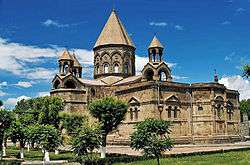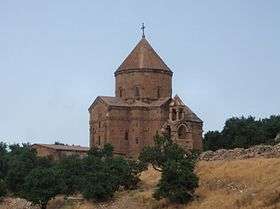Cathedral of Ani
Cathedral of Ani (Armenian: Անիի մայր տաճար, Anii mayr tačar; Turkish: Ani Katedrali) is the largest standing building in Ani, capital of medieval Bagratid Armenia, located in present-day eastern Turkey, on the border with modern Armenia. It was completed in the early 11th century by the architect Trdat and was the seat of the Catholicos, the head of the Armenian Apostolic Church, for nearly half a century.
| Cathedral of Ani | |
|---|---|
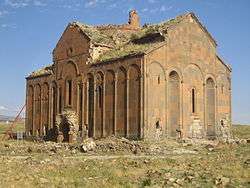 The cathedral in 2009 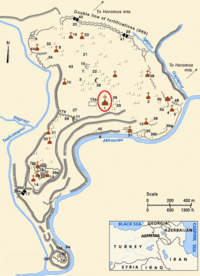 The cathedral displayed in a red circle within Ani | |
| Religion | |
| Affiliation | Armenian Apostolic Church |
| Location | |
| Location | Ani, Kars Province, Turkey |
| Geographic coordinates | 40.506206°N 43.572969°E |
| Architecture | |
| Architect(s) | Trdat |
| Type | Domed basilica |
| Style | Armenian |
| Groundbreaking | 989 |
| Completed | 1001 or 1010 |
| Specifications | |
| Length | 34.3 m (113 ft)[lower-alpha 1] |
| Width | 24.7 m (81 ft)[lower-alpha 1] |
| Height (max) | originally: 38 m (125 ft)[4] |
| Official name: Archaeological Site of Ani | |
| Type | Cultural |
| Criteria | ii, iii, iv |
| Designated | 2016 (40th session) |
| Reference no. | 1518 |
| Region | Western Asia |
In 1064, following the Seljuk conquest of Ani, the cathedral was converted into a mosque. It later returned to being used as an Armenian church. It eventually suffered damage in a 1319 earthquake when its conical dome collapsed. Subsequently, Ani was gradually abandoned and the church fell into disuse. The north-western corner of the church was heavily damaged by a 1988 earthquake.
The cathedral is considered the largest and most impressive structure of Ani. It is a domed basilica with a rectangular plan, though the dome and most of its supporting drum are now missing. Its use of pointed arches and cluster piers has been widely cited by scholars to have possibly influenced, or at least preceded, Gothic architecture. The cathedral, along with the entire site of Ani, was declared a World Heritage site by the UNESCO in 2016.
Names
In modern times, the cathedral is usually referred to in Armenian as Անիի մայր տաճար, Anii mayr tačar and in Turkish as Ani Katedrali,[5] both meaning "cathedral of Ani". Historically, however, it was known in Armenian as Անիի Կաթողիկե, Anii Kat'oghike.[6][7][lower-alpha 2] The cathedral is also known as Holy Mother of God Church of Ani (Armenian: Անիի Սուրբ Աստվածածնի եկեղեցի, Anii Surb Astvatsatsni yekeghetsi;[1][9] Turkish: Meryem Ana Katedral)[10] and the Great Cathedral of Ani (Մեծ Կաթողիկե, Mets Kat'oghike;[11] Büyük Katedral).[12][13][14]
History
Foundation and early history
Following more than two centuries of Arab rule, Armenia gained independence under the leadership of the Bagratid (Bagratuni) dynasty around 885. King Ashot III made Ani capital in 961, after which the city emerged as a prosperous urban center with 100,000 residents at its height.[15][16][17] The construction of the cathedral began in 989.[18] The architect Trdat was commissioned by Bagratid King Smbat II to build a cathedral in the new capital of the Armenian kingdom.[19][20] The construction was halted when Smbat died in 989, according to an inscription on the south wall.[21][1] Meanwhile, Trdat was hired to direct the repairs of the dome of the Hagia Sophia in Constantinople, which had collapsed in an earthquake.[22][18] Trdat returned from Constantinople in 993.[23] The construction was continued and completed by Queen Katranide[1][24][25] (Katramide),[26] the wife of King Gagik I, Smbat's brother and successor.[21] It was completed either in 1001 or 1010.[lower-alpha 3] According to Christina Maranci the generally accepted date of completion is 1001, but it may have extended until 1010.[19] The contradiction is based on the reading of the inscription of the cathedral's northern wall.[37][38] The cathedral served as the seat of the catholicos,[26] the head of the Armenian Apostolic Church from its foundation in 1001[39] until the mid-11th century (1046 or 1051).[40][41] Thus, for around half a century Ani was both the religious and secular center of Armenia.[39]
A silver cross originally stood on its conical dome and a crystal chandelier, bought by King Smbat II from India, hang in the cathedral. In the 1010s, during the reign of Catholicos Sarkis I, a mausoleum dedicated to the Hripsimean virgins was erected next to the cathedral. The mausoleum was built on some of the remnants of the virgins brought from Vagharshapat (Etchmiadzin).[26] In the 1040s–1050s inscriptions were left on the cathedral's eastern and western walls about urban projects, such as restoration of defensive walls, installation of water pipes and easing of the tax burden on the residents of Ani.[1]
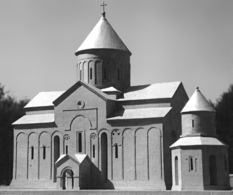 Reconstruction of the cathedral's original state by Toros Toramanian.[lower-alpha 4]
Reconstruction of the cathedral's original state by Toros Toramanian.[lower-alpha 4]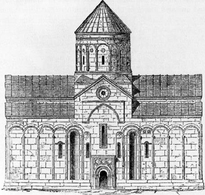 Reconstruction of the cathedral by Charles Texier (1842)[18]
Reconstruction of the cathedral by Charles Texier (1842)[18] Reconstruction of the cathedral by Wilhelm Lübke (1881)[42]
Reconstruction of the cathedral by Wilhelm Lübke (1881)[42] Cross section of the church per Toramanian[43]
Cross section of the church per Toramanian[43]
Later history
Ani surrendered to the Byzantine Empire in 1045, who held it until 1064, when the city was captured by the Seljuks, led by Alp Arslan.[44] Alp Arslan and his soldiers performed their first prayer in Ani at the cathedral.[12] Consequently, the cathedral was converted into a mosque[1][10] and called Fethiye Mosque[45][46] (Turkish: Fethiye Cami).[lower-alpha 5] Official Turkish sources often refer to it by that name.[51]
In 1124 a crescent was placed on the cathedral's dome by the Shaddadid amir of Ani. In response, the Armenian population asked King David IV of Georgia to capture Ani, after which the cathedral returned to Christian usage.[1][38] However, only two years later, in 1126, Ani came under the control of the Shaddadids.[1] During the 12th century historians Mkhitar Anetsi, Samuel Anetsi and philosopher Hovhannes Sarkavag served at the cathedral in various capacities.[1] Mkhitar Anetsi was an elder priest at the cathedral in the second half of the 12th century.[52] In 1198 Ani was conquered by the Georgian-Armenian Zakarid (Mkhargrdzeli) princes, under whose control the cathedral prospered. In 1213 the wealthy merchant Tigran Honents restored the cathedral's steps.[1]

Decay
Ani's long-term decline began in 1239 when Mongols sacked the city and massacred its population.[53] In 1319 a devastating earthquake struck Ani. It resulted in the collapse of the cathedral's conical roof.[1][24][38] Ani was completely deserted by the 18th century.[54] The drum reportedly collapsed during an 1832[38] or 1840[55] earthquake. The north-western corner of the cathedral was heavily damaged by a 1988 earthquake with its epicenter in modern Armenia's north.[1] It resulted in a large gaping hole. According to VirtualAni it also caused "a serious rent in the south-west corner; by 1998 parts of the roof here had started to fall."[38] Lavrenti Barseghian wrote in 2003 that the damage from the earthquake was so great that the entire building would collapse unless strengthened and restored.[56]
Explosions in a quarry on the Armenian side of the border, across the Akhurian River, reportedly caused some damage to the cathedral in the early 2000s.[57][38] In mid-June 2001 an "ear-splitting explosion rocked the site just as a group of Armenian Americans had gathered to pray at the cathedral."[58] Armenian architectural historian Samvel Karapetyan, who witnessed the explosions on the Armenian side during his visit to Ani in July 2000, stated that the explosions continued until 2004/2005.[59] However, Turkish accusations continued until 2008.[10] According to an article in Hürriyet by Vercihan Ziflioğlu, it was only in 2009 that Armenia halted blasting activities, reportedly, after Turkey's complaint at the International Council on Monuments and Sites (ICOMOS).[60]
Architecture
Overview
The cathedral is a domed, centrally-planned basilica.[lower-alpha 6] According to Richard Krautheimer it derives its plan from that of the 7th century cathedral of Talin, with only minor differences.[62] The dome was supported on pendentives and stood atop the "intersection of four barrel vaults elevated to a cruciform design and topped with gabled roofs." In the interior, "freestanding piers divide the space into three aisles, the nave of which terminates in an eastern apse flanked by two story side chapels."[63] Sirarpie Der Nersessian noted that its interior is imposing "through the harmony of the proportions." She added, "The blind arcade with slender columns and ornate arches, the delicate interlaces carved around the door and windows add to the beauty of the exterior."[64]
The cathedral is built, primarily, of yellow, but also black and red polished tufa. It has three entrances. The main one is on the western side. The entrances on the northern and southern sides, though secondary, are richly decorated. Its windows are narrow and long, with ornamented frames.[2]
- Dimensions
The cathedral is 34.3 m (113 ft) long and 24.7 m (81 ft) wide.[lower-alpha 1] Originally standing 38 m (125 ft) high,[4] it was Ani's tallest structure.[6] It is very large by the standards of Armenian architecture.[9] Architecture historian Murad Hasratyan suggests that its relatively large size and rich ornaments symbolize the revived Armenian statehood under the Bagratids.[1] Christina Maranci suggested what she describes as an "extremely tentative" hypothesis that the relatively large proportion of the cathedral may have been a "reflection of Trdat's memory of the vast continuous spaces" of Hagia Sophia in Constantinople, the dome of which he repaired.[65] However, it is considered small if judged by a European standard, wrote H. F. B. Lynch and added, "it is nevertheless a stately building. It bears the imprint of that undefinable quality, beauty, and can scarcely fail to arouse a thrill of delight in the spectator."[66] Luigi Villari wrote in his 1906 book on travels in the Caucasus: "From a distance it seems to be merely a plain rectangular structure with no architectural pretensions. But on closer inspection it proves to be a building of really great beauty and of the most perfect proportions."[67]
Scholarly assessment
The cathedral is widely considered a masterpiece of Armenian architecture.[lower-alpha 7] It is the largest and most impressive structure of Ani.[48][69] Armen Kazaryan describes it as the most significant structure of the entire Bagratid period.[70] The cathedral is known for its novel design features.[9] Authors of Global History of Architecture wrote that it "deserves to be listed among the principal monuments of the time because of its pointed arches and clustered columns and piers."[28] Josef Strzygowski argued that the cathedral is the most valuable achievement of Armenian architecture from the European viewpoint.[71] David Marshall Lang wrote that the cathedral's building techniques are "far ahead of the contemporary Anglo-Saxon and Norman architecture of western Europe."[72] H. F. B. Lynch wrote: "The impression which we take away from our survey of these various features is that we have been introduced to a monument of the highest artistic merit, denoting a standard of culture which was far in advance of the contemporary standards in the West."[73] Sirarpie Der Nersessian wrote that it "deserves to be listed among the important examples of medieval architecture."[64] The New International Encyclopedia characterized it as the "most interesting church of Armenia."[74] David Roden Buxton suggested that the cathedral deserves far more fame than it actually has.[lower-alpha 8] Richard Phené Spiers wrote in the Encyclopædia Britannica Eleventh Edition (1911):
The most important example of the Armenian style is found in the cathedral at Ani, the capital of Armenia, dating from A.D. 1010. In this church pointed arches and coupled piers are found, with all the characteristics of a complete pointed-arch style, which, as Fergusson remarks, "might be found in Italy or Sicily in the 12th or 14th century." Externally the walls are decorated with lofty blind arcades similar to those in the cathedral at Pisa and other churches in the same town, which are probably fifty years later. The elaborate fret carving of the window dressings and hood moulds are probably borrowed from the tile decoration found in Persia.[36]
Imitations in Armenian architecture
The main church of Marmashen monastery (dated 988–1029) is considered a miniature of Ani Cathedral.[76] Richard Krautheimer wrote that the exterior walls of both the church of Marmashen and the cathedral of Ani are "articulated by blind arcades resting on slender colonnettes, single or in pairs."[62] There are significant structural differences between the two.[77] Stepan Mnatsakanian noted that the similarities are limited to the exterior decorations because there are significant differences in their floor plans.[78]
The ground plan of Holy Saviour's Church in Gyumri, completed in 1873, is based on that of Ani Cathedral.[79] However, the church is significantly larger than the cathedral and is not an exact replica of the latter.[80]
The blind arcades on the three apses of the Armenian Cathedral of Lviv—added sometime before 1902—are a "surprisingly faithful reproduction of an analogous decoration" on the external walls of cathedral of Ani.[81]
Association with Gothic architecture
Some European scholars, especially scholars of the Near East,[82] have suggested that the use of pointed arches and clustered piers in the cathedral influenced the development of Gothic architecture. The theory was popularized by Josef Strzygowski, who was the first European to thoroughly study Armenian architecture and placed Armenia in the center of European architecture.[83] Strzygowski wrote in the Origin of Christian Church Art (1920): "It is a delight, in a church earlier than AD 1000, to see the builder, the court architect Trdat, carrying Armenian art so logically and so successfully past 'Romanesque' to 'Gothic'."[84][82] Several scholars had proposed this view before Strzygowski. H. F. B. Lynch in his book on Armenia published in 1901 suggested that the cathedral has "many of the characteristics of the Gothic style, of which it establishes the Oriental origin."[73] William Lethaby found the cathedral "strangely western." He wrote in Medieval Art (1912) that it is especially remarkable because its pointed arches, clustered piers, ribs and colonnades correspond to the Gothic of a hundred years later.[85][82] Edith Browne wrote in 1912 that the cathedral is "a very specimen of transition to the Gothic style."[86]
In examining the possible influence of Caucasian architecture in the West, David Roden Buxton wrote on the cathedral of Ani in 1937:[75]
... inside it bears the semblance of a Gothic cathedral such as Western Europe might have seen two centuries later. Pairs of clustered columns support a high pointed vault, and on either side is an aisle with narrow pointed arches like those of the "Early English" style. It is assuredly a striking example of parallel evolution, even if all idea of a connection with the Gothic must be dismissed.
Cecil Stewart noted that the most interesting features of the cathedral are its "pointed arches and vaults and the clustering or coupling of the columns in the Gothic manner."[87] For David Talbot Rice the cathedral is "astonishingly Gothic in every detail."[31] David Marshall Lang argued that the appearance of pointed arches and clustered piers together is "considered one of the hallmarks of mature Gothic architecture."[72]
The theory found support among Armenian architecture historians, such as Toros Toramanian,[24] Tiran Marutuan,[88] Murad Hasratyan.[lower-alpha 9] Rouben Paul Adalian wrote, "the interior with its pointed arches and clustered piers rising to the ribbed ceiling vaults, included innovations whose parallels would appear in Gothic architecture in Western Europe a century later."[9] Armen Der Kiureghian wrote that the cathedral is "significant from an architectural standpoint, as it contains elements of Gothic architecture, i.e., clustered columns and pointed arches, long before they appeared in Europe."[89]
According to World Monuments Fund the cathedral is "often considered a source of inspiration for many of the key features of Gothic architecture, which became a dominant architectural style in western Europe more than a century later."[68] The Ambassadors Fund for Cultural Preservation suggested that the cathedral "[bears] silent witness to the origins of the Western Gothic style."[90]
- Criticism and response
Art historian Sirarpie Der Nersessian rejected the postulated "proto-Gothic" character of the ogival arches of the cathedral of Ani which, she argued, "do not serve the same function in supporting the vault."[91] Although Adrian Stokes saw the cathedral as holding "some balance between wall architecture and the linear Gothic to come," he did not find "the feeling for mass and space that transfixes him at Rimini or Luciano Laurana's Quattro Cento courtyard in the Palace of Urbino."[82] The website Virtual Ani writes that there is "no evidence to indicate that there was a connection between Armenian architecture and the development of the Gothic style in Western Europe."[38] Lucy Der Manuelian argues that there is a documented evidence of the presence of Armenians in Western Europe during the Middle Ages, who could have carried this information to the West.[92]
Preservation efforts and controversy

Ani has been listed on the World Monuments Watch by World Monuments Fund (WMF) since 1996.[93] In May 2011 the WMF and the Turkish Ministry of Culture launched what they call a conservation project focusing on the cathedral and the nearby Church of the Redeemer.[94] The project is funded by the Ambassadors Fund for Cultural Preservation of the U.S. State Department.[90] Before the project a steel structure was installed around the cathedral, said to prevent its cracked sandstone walls from collapsing.[93] The WMF and its Turkish partner, the NGO Anadolu Kültür, say they will work on "stabilization and protection" of the cathedral.[68] Turkey's Minister of Culture Ertuğrul Günay stated "We hope that giving new life to the remains of once-splendid buildings, such as the Ani Cathedral and church, will bring new economic opportunities to the region."[94][95] Armenian officials responded with skepticism.[96] According to Gagik Gyurjyan, president of ICOMOS-Armenia, the Turkish Ministry of Culture rejected the preliminary agreement between Anadolu Kültür and the Armenian side to engage Armenian experts in restoration works. Osman Kavala, president of Anadolu Kültür, stated that the lack of formal bilateral relations between Armenia and Turkey may have prevented Armenian experts from being included in the project. Kavala stated in a 2011 interview that an estimated $1 million would be spent on the project, which was scheduled to start in 2012 and end in 4 years.[97] Yavuz Özkaya, an architect who participated in the projects carried out in Ani, stated in March 2014 that studies on preservation and restoration of the cathedral were completed and they had begun to be implemented. These works included clearing the roofs, installing a temporary structure at the separation point between the western and southern walls, strengthening, proper completion of roof tiles and taking preventative measures.[98]
The archaeological site of Ani was inscribed as a UNESCO World Heritage Site on July 15, 2016.[99] According to art historian Heghnar Watenpaugh the addition "would secure significant benefits in protection, research expertise, and funding."[100] In April 2018 Necmettin Alp, director of the Kars Museum, stated that restoration works on the cathedral would start later that month.[101][102]
Politics

In 1989 a series of events under the title "The Glory of Ani" commemorating the millennium of the Cathedral of Ani took place in the United States, sponsored by the Eastern Prelacy of the Armenian Apostolic Church of America. A symposium took place at the New-York Historical Society on October 21, 1989.[103][104]
On July 23, 2008 Turkish President Abdullah Gül visited Ani and the cathedral.[105]
In June 2011 the graduation ceremony of undergraduate and graduate students of the History Department of the Yerevan State University (YSU) was held at the cathedral.[106] Since then graduation ceremonies of some departments of the YSU have taken place at the cathedral.[107] Folk dance director Gagik Ginosyan and his wife, along with their friends, staged a wedding ceremony at the cathedral.[107] On September 10–12, 2011 researchers of the Shirak Armenology Research Center of the National Academy of Sciences of Armenia made a pilgrimage to the cathedral, where they performed scientific readings on history of Ani.[108]
In February 2020 a video appeared online in which a woman sang meyhane music on the bema of the cathedral while Pervin Ersoy, the wife of Mehmet Ersoy, Turkey's Minister of Culture and Tourism, was shown standing in the crowd and clapping.[109][110][111][112]
2010 Muslim prayer
On October 1, 2010 a Muslim prayer was performed at the cathedral by members and supporters of the far-right Nationalist Movement Party (MHP). The formal occasion was to commemorate the 1064 Seljuk conquest of Ani, but it was widely seen as a nationalist retaliation for the Christian mass—the first since the Armenian Genocide of 1915—at the Cathedral of Aghtamar at Lake Van on September 19.[113][50][114] Some two thousand people, including senior members of the MHP, such as party leader Devlet Bahçeli, participated in the prayer.[47] The crowd waved Turkish flags and chanted Allahu Akbar before saying prayers in and around the cathedral. They were accompanied by an Ottoman-style military marching band.[18][51] The prayer was authorized by the Turkish Ministry of Culture,[50] and was attended by believers from Azerbaijan and broadcast live by three Azerbaijani TV channels.[115]
The prayer was widely denounced for its political nature. An MP from the ruling AKP called it an illegal "political show" connected with the Aghtamar mass,[46] while art historian Heghnar Watenpaugh described the event as an example of "political stagecraft."[114] According to Aris Nalcı of the Turkish-Armenian daily Agos it was "addressed to Turks, rather than Armenians."[116] According to commentary prepared by the Yapı Kredi Bank Economic Research, "the scene looked awkward to a large majority of Turks."[117] Hürriyet Daily News columnist Yusuf Kanlı described it as an "attempt [by Bahçeli] to woo and win back the lost nationalist-conservative vote."[118] Turkish-Armenian journalist Markar Esayan wrote in Taraf that what Bahçeli did at Ani was "in fact exploitation of religion."[119]
The Armenian Apostolic Church, in an issued statement, accused the Turkish authorities in "destroying Armenian monuments and misappropriating historical Armenian holy sites and cultural treasures."[120] Architecture scholar Samvel Karapetyan commented sarcastically: "We now have reason to be happy. For centuries, our churches were desecrated and turned into toilets, whereas now they are only doing a namaz [sic]."[51]
Gallery
 Western façade
Western façade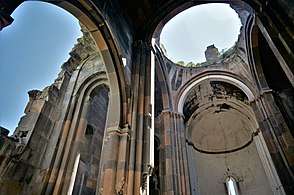 Interior view
Interior view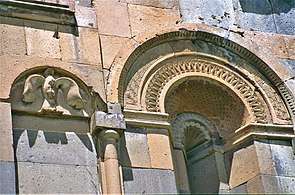 Detail on the south façade
Detail on the south façade South & west sides, with the Church of the Redeemer behind
South & west sides, with the Church of the Redeemer behind
- Historic and artistic depictions
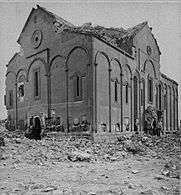 A stereoscopic photograph from the southwest, by Onnes Kurkdjian, between 1875 and 1880
A stereoscopic photograph from the southwest, by Onnes Kurkdjian, between 1875 and 1880 A photo of the cathedral published in a 1901 book by H. F. B. Lynch[121]
A photo of the cathedral published in a 1901 book by H. F. B. Lynch[121]
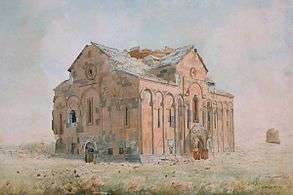 Watercolour by Arshak Fetvadjian, 1905
Watercolour by Arshak Fetvadjian, 1905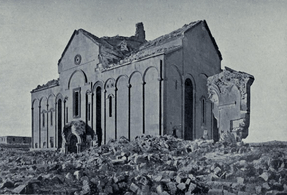 by Peshdimaldjian, published in 1912[86]
by Peshdimaldjian, published in 1912[86]
References
- Notes
- According to Murad Hasratyan: 34.3 by 24.7 metres (113 by 81 ft).[1] According to Tadevos Hakobyan: 34.3 by 21.9 metres (113 by 72 ft).[2] According to Toros Toramanian's plan: 34.3 by 21.9 metres (113 by 72 ft).[3] The interior of the cathedral according to Tadevos Hakobyan has the following dimensions: 32 by 19.7 metres (105 by 65 ft).[2]
- Kat'oghike is a term used for several major cathedrals, such as Etchmiadzin Cathedral, Armenia's mother church.[8]
- 1001[22][27][24][28][29][30][25][31][32][33][34] or 1010[35][36]
- The smaller structure on the right is the mausoleum dedicated to the Hripsimean virgins.
- [10][13][14][47] Fethiye Cami is variously translated as "victory mosque",[38][48] "conquer mosque",[49] or "conquest mosque".[50]
- "a fusion between basilica and central plan"[29] "In its form, the Cathedral is a centrally-planned basilica."; "Christina Maranci has analyzed the ways in which the cathedral at Ani innovates the domed basilica type ..."[18] "..domed basilicas like the Ani Cathedral ..."[61]
- "indisputably one of the masterpieces of Armenian architecture"[32] "a masterpiece of Armenian medieval architecture"[68] "հայ ճարտարապետության գլուխգործոցներից մեկը"[56]
- "The cathedral of Ani is worthy (if, indeed, it still exists) of far greater renown that actually surrounds it."[75]
- Եկեղեցու ներսի այդպիսի լուծումը, հատկապես մույթերի՝ ջլաղեղների նմանությամբ մասնատումը XII–XIV դդ. դարձել են Արմ. Եվրոպայում ձևավորված ու տարածված գոթական ճարտարապետության բնորոշ հատկանիշները: English: These elements, especially the flying buttress (arc-boutant) in the form of nervures were common characteristics of Gothic architecture which originated and spread in Western Europe in the 13th–14th centuries.[1]
- References
- Hasratyan 2002.
- Hakobyan 1988, p. 118.
- Strzygowski 1918, p. 185.
- Ghulyan, Artak, "Անիի Մայր տաճարի հազարամյա խորհուրդը (1001-2001 թթ.)" [The 1,000-Year Mystery of the Cathedral in Ani], in: Հուշարձան [Hushardzan], vol. 3, ed. Hakob Simonyan, Yerevan 2005, 26-40
- "Ani Tarihi Kenti (Kars)". kulturvarliklari.gov.tr (in Turkish). Turkish Ministry of Culture and Tourism, Cultural Assets and Museums General Directorate. Archived from the original on 2016-03-18.
Ani Katedrali (Fethiye Camii)
- Petrosyan, Sargis; Petrosyan, Lusine (2014). "Անին և Երվանդունիները [Ani and the Orontids of Armenia]". Research Papers (in Armenian). Shirak Armenology Research Center - National Academy of Sciences of Armenia (14): 27.
Անիում Սուրբ Աստվածածնի պաշտամունքի մասին է խոսում այն փաստը, որ քաղաքի ամենաբարձր շինությունը' Մայր տաճարը (Կաթողիկե եկեղեցին), ձոնված Էր նրան:
- Avagyan 1979, p. 70.
- Matevosyan, Karen (2009). "Արուճի և Թալինի պատմության էջեր [Histories of Aruch and Talin]". Etchmiadzin (in Armenian). 65 (1): 52.
Եկեղեցիներին տրվող «Կաթողիկե» անունն ունի երկու նշանակություն՝ գմբեթավոր և գլխավոր։ Այդպես են կոչվել էջմիածնի Մայր տաճարը, Դվինի կաթողիկոսարանի եկեղեցին, ավելի ուշ՝ Անիի Մայր տաճարը։
- Adalian, Rouben Paul (2010). Historical Dictionary of Armenia. Lanham, Maryland: Scarecrow Press. p. 81. ISBN 978-0-8108-7450-3.
- Sağsöz, Onur (31 October 2008). "Ermenistan'a Ani için rica". Hürriyet (in Turkish). Archived from the original on 8 April 2020.
- Matevosyan 2008, p. 5.
- İpek, Ali (2009). "Sultan Alp Arslan'in Ani̇ Ermeni̇leri̇ne Karşi Tutumu [Sultan Alparslan's Attitude Towards Armenians of Ani]". Ekev Academic Review (in Turkish). 13 (39): 371–380. ISSN 1301-6229.
- "Büyük Katedral (Fethiye Cami) - Kars". kulturportali.gov.tr (in Turkish). Turkish Ministry of Culture and Tourism.
- Erzeneoğlu, Abdulkadir (26 April 2012). "Ani Harabeleri, günümüzde yeterince tanınmadı" (in Turkish). Cihan News Agency.
... 1001 yılında yapımı tamamlanan Büyük Katedral yani Fethiye Cami ...
- Panossian, Razmik (2006). The Armenians: From Kings and Priests to Merchants and Commissars. New York: Columbia University Press. p. 60. ISBN 9780231139267.
- Payaslian 2007, p. 66.
- Hacikyan, Agop Jack; Basmajian, Gabriel; Franchuk, Edward S.; Ouzounian, Nourhan (2002). The Heritage of Armenian Literature: From the sixth to the eighteenth century. Detroit: Wayne State University Press. p. 183. ISBN 978-0-8143-3023-4.
- Watenpaugh 2014b, p. 465.
- Maranci 2003, p. 304.
- Piltz, Elisabeth (2007). From Constantine the Great to Kandinsky: Studies in Byzantine and Post-Byzantine Art and Architecture. Archaeopress. p. 24. ISBN 978-1-4073-0104-4.
The domed cathedral in Ani was elevated by the famous architect Trdat who repaired the collapsed dome in Hagia Sophia in Constantinople and was commissioned by King Smbat II shortly before his death in 989 for this reign of his successor King Gagik I.
- Maranci 2003, p. 299.
- Maranci 2003, p. 294.
- Hasratyan 2011, p. 13.
- "Անիի Մայր տաճար [Ani Cathedral]". Soviet Armenian Encyclopedia Volume I (in Armenian). 1974. p. 413.
- "Historic City of Ani". UNESCO. 2012. Archived from the original on 12 July 2016.
The Cathedral of Ani is one of the most important buildings in the site. Commissioned by the Armenian King Smbat Bagratuni II in 989, it was completed by his successor's wife, Queen Katranidē by 1001. Its architect, Trdat, also participated in repairing the dome of Hagia Sophia in Constantinople.
- Matevosyan 2008, p. 11.
- Hakobyan 1988, p. 117.
- Ching, Francis D. K.; Jarzombek, Mark M.; Prakash, Vikramaditya (2010). A Global History of Architecture. John Wiley & Sons. p. 355. ISBN 978-1-118-00739-6.
- Kouymjian, Dickran. "Ani Cathedral". Armenian Studies Program California State University, Fresno. Archived from the original on 10 September 2012.
- Kazaryan, A.; Mikhaylov, P. (3 March 2009). "Ани [Ani]". Orthodox Encyclopedia Volume II (in Russian). Russian Orthodox Church. pp. 433–434.
Кафедральный собор А. (989–1001, наос 22´ 34 м, зодчий Трдат), 4-столпный крестово-купольный храм, построен при католикосе Хачике I Аршаруни.
- Talbot Rice, David (1972). The Appreciation of Byzantine Art. Oxford University Press. p. 179.
The interior of Ani cathedral, a longitudinal stone building with pointed vaults and a central dome, built about 1001, is astonishingly Gothic in every detail, and numerous other equally close parallels could be cited.
- Gasapean, Gurgēn; Tasnapetean, Hrach (1972). Monuments of Armenian Architecture. Beirut: Hamazkaine. p. x. OCLC 678007.
The Cathedral of Ani, which he completed in 1001, is indisputably one of the masterpieces of Armenian architecture.
- Stone, Nira; Stone, Michael E. (2007). The Armenians: Art, Culture and Religion. Chester Beatty Library. p. 48. ISBN 978-1-904832-37-9.
The cathedral in Ani was completed in ad 1001.
- Evans, Helen C. (1997). "The Armenians". In Evans, Helen C.; Wixom, William D. (eds.). The Glory of Byzantium: Art and Culture of the Middle Byzantine Era, A.D. 843–1261. New York: Metropolitan Museum of Art. p. 352. ISBN 978-0-87099-777-8.
- Hewsen, Robert H. (2001). Armenia: A Historical Atlas. University of Chicago Press. p. 114. ISBN 978-0-226-33228-4.
- Spiers, Richard Phené (1911). . In Chisholm, Hugh (ed.). Encyclopædia Britannica. 2 (11th ed.). Cambridge University Press. p. 391.
- Avagyan 1979, pp. 70–71.
- "The Cathedral of Ani". virtualani.org. Virtual Ani. Archived from the original on 7 April 2016.
- Matevosyan, Rafayel (1978). "Անին արքունի աթոռանիստ և մայրաքաղաք [Ani as royal residence and capital]". Lraber Hasarakakan Gitutyunneri (in Armenian) (5): 93–94.
Սմբատ Բ ֊ն սկիզբ դրեց նոր կաթողիկեի կառուցմանը Անիում, որը ավարտվեց 1001 թ.՝ Գագիկ Ա֊ի օրոք։ Այսպիսով կաթողիկոսարանը տեղափոխվեց մայրաքաղաք, որտեղ կենտրոնացավ թե՛ աշխարհիկ և թե՛ հոգևոր գերագույն իշխանությունը: = Smbat II began the construction of a new cathedral in Ani, which was completed in 1001 during the reign of Gagik I. Thus, the catholicosate moved to the capital. where both secular and religious supreme government concentrated.
- Matevosyan, Karen (2002). "Անիի կաթողիկոսարան [Ani Catholicosate]" (in Armenian). Yerevan State University Institute for Armenian Studies. Archived from the original on 8 April 2020.
- "The Hierarchical Sees - Locations". armenianchurch.org. Mother See of Holy Etchmiadzin. Archived from the original on 8 April 2020.
- Lübke, Wilhelm (1881). Cook, Clarence (ed.). Outlines of the History of Art Volume I. New York: Dodd, Mead, and Company. p. 440.
- Strzygowski 1918, p. 187.
- Payaslian 2007, p. 73.
- Watenpaugh 2014b, p. 466.
- "Turkey Approves Muslim Prayer Service In Armenian Church". Radio Free Europe/Radio Liberty. 1 October 2010.
- Yardimciel, Mukadder; Özonur, Nursima; Tercanlı, Kürşat (1 October 2010). "Bahçeli ve 2 bin MHP'li, Ani'de namaz kıldı". Radikal (in Turkish).
- Campbell, Verity (2007). Turkey. Lonely Planet. p. 582. ISBN 978-1-74104-556-7.
... the cathedral, renamed the Fethiye Camii (Victory Mosque) by the Seljuk conquerors, is the largest and most impressive of the buildings.
- Özükan, Bülent (2003). "Virgin Mary Cathedral". Türkiye'nin kutsal mekanları [Holygrounds of Turkey]. Boyut Yayın.
After the seizure of Ani by Alparslan in 1064, it was converted to a mosque and was called as Fethiye (Conquer) Mosque.
- "Turkey's nationalist party holds Friday prayers at Ani ruins". Hürriyet Daily News. 1 October 2010. Archived from the original on 2017-01-08. Retrieved 2016-07-14.CS1 maint: BOT: original-url status unknown (link)(, PDF version)
- Danielyan, Emil (8 October 2010). "Turkish Nationalist Rally In Church Angers Armenians". Eurasia Daily Monitor. 7 (182). Jamestown Foundation. Archived from the original on 2017-02-04.
- Poghossian Rev. Fr. Matheos (2009). "Հառիճավանքը դարերի հոլովույթում [The Monastery of Harij in the course of centuries]". Etchmiadzin (in Armenian). 65 (3): 66.
- Saunders, J. J. (1971). The History of the Mongol Conquests. University of Pennsylvania Press. p. 71.
- Watenpaugh 2014b, p. 464.
- Hakobyan 1988, p. 119.
- Barseghian, Lavrenti (2003). "Կրկին անգամ Անի-Երերույք պատմա-հնագիտական միջազգային արգելոց կազմակերպելու հարցի շուրջ [Once again about organization of the international historical archeological reserve in Ani-Yereruyk]". Issues of the History and Historiography of the Armenian Genocide (in Armenian) (8): 7.
Նախնական տվյալների համաձայն 1988թ. դեկտեմրերի 7-ի երկրաշարժից մեծապես տուժել է հայ ճարտարապետության գլուխգործոցներից մեկը' Անիի Մայր տաճարը, որը կառուցվել է 1001 թվականին: Փլուզվել է տաճարի հյուսիս-արևմտյան անկյունը, որի հետևանքով խարխլվել է ամբողջ կառույցը և եթե անհրաժեշտ վերանորոգման և ամրացման աշխատանքներ չձեռնարկվեն, ապա մոտ ապագայում ավերակի կույտի կվերածվի դեռևս կանգուն եկեղեցին: = According to preliminary information, the cathedral of Ani, built in 1001, one of the masterpieces of Armenian architecture, was severely damaged by the earthquake of December 7, 1988. Its north-western corner has collapsed, because of which the entire structure has been undermined and if the necessary restoration and strengthening is not done, the church will collapse.
- "Stone quarries threaten Ani ruins in Kars". Hürriyet Daily News. 7 October 2001. Archived from the original on 2016-08-07. Retrieved 2016-07-14.CS1 maint: BOT: original-url status unknown (link)(, PDF version)
- Zaman, Amberin (30 August 2001). "As a Rare Cathedral Crumbles, Two Rival Nations Point Fingers". Los Angeles Times.
- Karapetyan, Samvel (20 October 2012). "Մենք նպաստել ենք Անիի կործանմանը [We have contributed to the destruction of Ani]" (in Armenian). Samvel Karapetyan on YouTube.
- Ziflioğlu, Vercihan (14 April 2009). "Building a dialogue atop old ruins of Ani". Hürriyet. Archived from the original on 12 July 2016.
- Wharton, Alyson (2015). The Architects of Ottoman Constantinople: The Balyan Family and the History of Ottoman Architecture. I.B. Tauris. p. 62. ISBN 978-1-78076-852-6.
- Krautheimer, Richard (1965). Early Christian and Byzantine Architecture. Penguin Books. p. 234.
The exterior walls are covered with decorative sculpture, as at Aght'amar; or they are articulated, as at the cathedrals of Ani and Marmashen (986–1029), by blind arcades resting on slender colonnettes, single or in pairs. ... Monastery at Goshavank, built in 928–953, and the cathedral of Ani of 989–1001 both take up the plan of the cathedral of Talin with only minor differences.
- Maranci 2003, p. 301.
- Der Nersessian, Sirarpie (1945). Armenia and the Byzantine Empire. Cambridge, Massachusetts: Harvard University Press. pp. 73–75.
- Maranci 2003, pp. 302, 304.
- Lynch 1901, p. 371.
- Villari, Luigi (1906). Fire and Sword in the Caucasus. London: T. Fisher Unwin. p. 302–303.
- "Ani Cathedral". World Monuments Fund. Archived from the original on 9 April 2020.
- Kinzer, Stephen (8 October 2000). "A Hidden Empire in Turkey". The New York Times.
- Kazaryan, Armen (2017). "The "Classical" Trend of the Armenian Architectural School of Ani: The Greco-Roman Model and the Conversion of Medieval Art". In Torlone, Zara Martirosova; Munteanu, Dana LaCourse; Dutsch, Dorota (eds.). A Handbook to Classical Reception in Eastern and Central Europe. John Wiley & Sons. p. 533. ISBN 978-1-118-83271-4.
- Marutian, Tiran (1990). "When Was Ani Cathedral Constructed?". The Armenian Review. 43 (3): 96.
- Lang, David Marshall (190). Armenia: Cradle of Civilization. London: Allen & Unwin. p. 223.
- Lynch 1901, p. 372–373.
- "Armenian Art". New International Encyclopedia Volume II (2nd ed.). New York: Dodd, Mead and Company. 1928. p. 139.
The culmination of a new style appears in the cathedral of Ani (1010 A.D.), the most interesting church of Armenia.
- Buxton, David Roden (1937). Russian Mediaeval Architecture with an Account of the Transcaucasian Styles and Their Influence in the West. Cambridge University Press. pp. 90–91.
- Conway, Martin (19 February 1916). "Churches of northern Armenia". Country Life. 39: 247.
... the ruined convent of Marmashen in the neighbourhood of Alexandropol. ... The church (988–1029) is a miniature of Ani Cathedral, but with a many-gabled dome such as was common in those days.
- Armen, Garbis (1992). An Architecture of Survival. p. 54. OCLC 30076050.
Church of the Complex of Marmashen Marmashen is a monastic complex with a church similar to the Cathedral of Ani, but with an important structural difference. The complex was built between 986 and 1029; the main church was probably built later than the Cathedral.
- Balasanian, Hayk (2008). "Մարմաշենի ճարտարապետական համալիրը և նրա վիմագրերը [The Architectural Complex of Marmashen and its Inscriptions]". Echmiadzin (in Armenian). 64 (6–7): 122.
- "Giumri 12: Freedom Square: Surb Mair Astvatsatsin (Yot Verk), Surb Amenaprkich". armenianheritage.org. Armenia Monuments Awareness Project.
Amenaprkich Cathedral. Constructed between the 1850s and 1870s, the cathedral is based on the 10th century cathedral of Ani ...
- "St. All Saviours". gyumri.am. Gyumri Municipality.
The floor plan of the church looks like the Ani mother cathedral; however it is not the exact replica. St. All Saviors is much bigger, higher and has richer ornaments.
- Wolańska, Joanna (2010). "The Designs of Józef Mehoffer for the Armenian Cathedral in Lvov (1907–1913): Circumstances, Sources of Inspiration and Execution". Artibus et Historiae. 31 (62): 189–231. JSTOR 25822481.
- Kite, Stephen (September 2003). "'South Opposed to East and North': Adrian Stokes and Josef Strzygowski. A study in the aesthetics and historiography of Orientalism". Art History. 26 (4): 505–533. doi:10.1111/j.0141-6790.2003.02604002.x.
- Buxton, David Roden (1975). Russian Mediaeval Architecture with an Account of the Transcaucasian Styles and Their Influence in the West. New York: Hacker Art Books. ISBN 978-0-87817-005-0.CS1 maint: ref=harv (link) Reprint of the 1934 ed. published by the Cambridge University Press, pp. 74, 98
- Strzygowski 1923, pp. 72–73.
- Lethaby, William (1912). Medieval Art: From the Peace of the Church to the Eve of the Renaissance, 312-1350. London: Duckworth. p. 78.
Ani Cathedral, built about 1010, is especially remarkable in having the dome upborne on pointed arches built in several recessed orders rising from piers also membered. The exterior is surrounded by a single storey of wall arches, while the apse within has a deeply recessed wall arcade of small scale, exactly like such arcades in the west. This in Texier's plan, in Mr. Lynch's photograph, and of the interior, seems strangely western.
- Browne, Edith A. (1912). Early Christian and Byzantine Architecture. London: A & C Black. p. 114.
- Stewart, Cecil (1959). History of Architectural Development: Early Christian, Byzantine and Romanesque Architecture. Longman. p. 80.
The most important examples of Armenian architecture are to be found at Ani, the capital, and the most important of these is the cathedral. ... The most interesting features of this building are its pointed arches and vaults and the clustering or coupling of the columns in the Gothic manner.
- Marutyan, Tiran (1997). "Գոթակա՞ն, թե" հայ-գոթական ճարտարապետական ոճ [Gothic or Armenian-Gothic architecture?]". Garun (in Armenian) (7): 54–56. (PDF version)
- Der Kiureghian, A. (May 20–24, 1990). "Observations from the Armenian earthquake of December 7, 1988". Proceedings, Fourth U.S. National Conference on Earthquake Engineering Volume I. Palm Springs, California: Earthquake Engineering Research Institute. pp. 145–146.
The cathedral in Ani significant from an architectural standpoint, as it contains elements of Gothic architecture, i.e., clustered columns and pointed arches, long before they appeared in Europe.
- "Turkey: Preserving the Legacy of a Lost City". usembassy.gov. Ambassadors Fund for Cultural Preservation. 19 November 2013. Archived from the original on 12 July 2016.
- Der Nersessian, Armenian Art, 1977, p. 101, cited in Garsoïan, Nina G. (2015). "Sirarpie Der Nersessian (1896–1989)". In Damico, Helen (ed.). Medieval Scholarship: Biographical Studies on the Formation of a Discipline: Religion and Art. Routledge. p. 300. ISBN 978-1-317-77636-9.
- Der Manuelian, Lucy (2001). "Ani: The Fabled Capital of Armenia". In Cowe, S. Peter (ed.). Ani: World Architectural Heritage of a Medieval Armenian Capital. Peeters: Leuven Sterling. p. 7. ISBN 978-90-429-1038-6.
- Brown, Matthew Hay; Hacaoglu, Selcan (4 May 2011). "In gesture, Turkey conserving Armenian churches". The Baltimore Sun. via Associated Press. (PDF version)
- "Turkey renovates Armenian monuments as gesture". Hurriyet Daily News. via Associated Press. 5 May 2011. Archived from the original on 7 August 2016.
- "Cultural gesture: Turkey intends to restore the cathedral in ancient Armenian city of Ani". ArmeniaNow. 6 May 2011. Archived from the original on 8 January 2017.
- "ՀՀ մշակույթի նախարարություն` Թուրքիան փոշի է փչում աշխարհի աչքերին Անիի մասին խոսելիս [Armenian Ministry of Culture: Turkey is blowing dust in the eyes of the world when talking about Ani]". mediamax.am (in Armenian). 7 June 2011. Archived from the original on 9 April 2020.
- Hambardzumyan, Hasmik (21 May 2011). "Հայ մասնագետները կմասնացե՞ն Անիի Մայր Տաճարի վերականգնմանը. Պարզաբանում է "Անադոլու Կուլտուր"-ի ղեկավարը [Will Armenian experts participate in the renovation of the cathedral of Ani?: Director of Anadolu Kultur clarifies]". panorama.am (in Armenian). Archived from the original on 9 April 2020.
- Sari, Lora (28 March 2014). "Ani zamana direniyor". Agos (in Turkish). Archived from the original on 11 February 2017.
- "Five sites inscribed on UNESCO's World Heritage List". UNESCOPRESS. UNESCO. 15 July 2016. Archived from the original on 9 April 2020.
- "Ani Included on UNESCO World Heritage List". Armenian Weekly. 15 July 2016. Archived from the original on 9 April 2020.
- "Ani'deki 'Büyük Katedral' restore edilecek" (in Turkish). Anadolu Agency. 14 April 2018. Archived from the original on 9 April 2020.
- "Medieval Ani Cathedral in eastern Turkey to go under renovation". Daily Sabah. 15 April 2018. Archived from the original on 8 April 2020.
- Watenpaugh 2014a, p. 551.
- Zarian, A. K. (1990). "Անիի Մայր տաճարի հիմնադրման 1000-ամյակին նվիրված համաժողով Նյու Յորքում [A congress, devoted to the 1000th anniversary of Ani's Mother Temple foundation in New York]". Lraber Hasarakakan Gitutyunneri (in Armenian) (7): 91–94.
- Hakobyan, Tatul (21 June 2015). "Աբդուլլահ Գյուլը՝ Բագրատունյաց թագավորության երկու մայրաքաղաքներում. օրվա լուսանկարը [Abdullah Gül in two capitals of the Bagratids]" (in Armenian). ANI Armenian Research Center. Archived from the original on 26 October 2017.
- "Армянские историки получили дипломы в кафедральном соборе Ани в Турции" (in Russian). REGNUM News Agency. 29 June 2011. Archived from the original on 8 April 2020.
- "Խոսող կոթողներ. Անիի Մայր տաճար [Talking monuments: Ani Cathedral]" (accompanying article) (in Armenian). Public Television of Armenia. 8 July 2015.
- Editorial Board. "Գիտական ընթերցումներ Անիի Մայր տաճարում [Scientific readings at Ani Cathedral]". Research Papers (in Armenian). Shirak Armenology Research Center, National Academy of Sciences of Armenia (14): 171–175.
- "I shared a video--and removed it. I misidentified someone as the wife of the Turkish Minister of Tourism, and she was not the one singing on stage of abandoned Armenian church. She was in the audience clapping. Please note my correction and my sincere apologies for the confusion". Louis Fishman on Twitter. February 7, 2020.
- Yarkadaş, Barış (February 8, 2020). "AKP'li bakanın eşinden komik savunma: 'Kilisenin akustiğini test ediyorduk'". YouTube.
- "Թուրք նախարարի կնոջ տգեղ արարքը Անիի Մայր տաճարում. Ermenihaber". Aravot (in Armenian). (via Ermenihaber). 10 February 2020. Archived from the original on 11 February 2020.
- "Մշակութային վանդալիզմ. թուրք երգչուհին երգում է Անիի Մայր տաճարում. տեսանյութ" (in Armenian). Sputnik Armenia. 10 February 2020. Archived from the original on 11 February 2020.
- "Turkish nationalists rally in Armenian holy site at Ani". BBC News. 1 October 2010. Archived from the original on 2017-11-10. Retrieved 2018-06-21.CS1 maint: BOT: original-url status unknown (link)()
- Watenpaugh 2014a, p. 544–545.
- "Անիում նամազ են անում [Namaz in Ani]". The Armenian Times (in Armenian). 1 October 2010. Archived from the original on 21 August 2016.
- "Turkish Nationalists Pray In Ancient Armenian Cathedral". Armenian Service of Radio Free Europe/Radio Liberty. 2 October 2010. Archived from the original on 8 April 2020.
- "General Outlook". Turkey Weekly Macro Comment. Yapı Kredi Bank, Strategic Planning and Research Section. 11 October 2010. pp. 2–3. Archived from the original on 22 January 2014. Retrieved 14 July 2016.
- Kanlı, Yusuf (1 October 2010). "Towards a two-party presidential Turkey". Hürriyet Daily News. Archived from the original on 7 August 2016.
- Esayan, Markar (14 October 2010). "Religion and politics in the Turkish political arena". Taraf.
- "Հայտարարություն [Announcement]". Etchmiadzin (in Armenian). 66 (10): 5. 2010.
- Lynch 1901, p. 370.
- "Անիի Աստվածամոր մայր տաճարը (1900) [Holy Mother of God Cathedral of Ani]" (in Armenian). National Gallery of Armenia. Archived from the original on 2016-07-11. Retrieved 2016-07-14.CS1 maint: BOT: original-url status unknown (link)()
Sources
- Avagyan, Suren (1979). "Անիի Մայր տաճարի շինարարական արձանագրության տարեթվերը [Date of the construction inscription of Ani Cathedral]". Lraber Hasarakakan Gitutyunneri (in Armenian) (11): 70–77.CS1 maint: ref=harv (link)
- Hakobyan, Tadevos Kh. (1988). Անի մայրաքաղաք [Ani the Capital] (in Armenian). Yerevan: Yerevan University Press. pp. 117–119.CS1 maint: ref=harv (link)
- Hasratyan, Murad (2002). "Անիի Մայր Տաճար (Cathedral of Ani)". In Ayvazyan, Hovhannes (ed.). "Քրիստոնյա Հայաստան" հանրագիտարան ("Christian Armenia" Encyclopedia) (in Armenian). Armenian Encyclopedia Publishing. pp. 63–64.CS1 maint: ref=harv (link)
- Hasratyan, Murad (2011). "Անիի ճարտարապետությունը [Architecture of Ani]". Patma-Banasirakan Handes (in Armenian) (3): 3–27.CS1 maint: ref=harv (link)
- Khanikof, Nikolai (1859). "Voyage a Ani, capitale de l'Armenie, sous les Bagratides". Revue Archéologique (in French). 15 (2): 401–420. JSTOR 41742572.
- Lynch, H. F. B. (1901). Armenia, travels and studies. Volume I: The Russian Provinces. London: Longmans, Green, and Co.CS1 maint: ref=harv (link)
- Maranci, Christina (2003). "The Architect Trdat: Building Practices and Cross-Cultural Exchange in Byzantium and Armenia". Journal of the Society of Architectural Historians. 62 (3): 294–305. doi:10.2307/3592516. JSTOR 3592516.CS1 maint: ref=harv (link)
- Matevosyan, Karen (2008). "Անին մայրաքաղաք և կաթողիկոսանիստ [Ani as a Capital and Catholicosate]". Patma-Banasirakan Handes (in Armenian) (3): 3–30.CS1 maint: ref=harv (link)
- Matevosyan, Karen (1989). "Անիի Մայր տաճարը — հոգևոր և մշակութային կենտրոն [Cathedral of Ani: spiritual and cultural center]". Etchmiadzin (in Armenian). 46 (11–12): 105–110.
- Payaslian, Simon (2007). The History of Armenia. New York: Palgrave Macmillan. ISBN 978-1-4039-7467-9.CS1 maint: ref=harv (link)
- Strzygowski, Josef (1918). Die Baukunst der Armenier und Europa [The Architecture of the Armenians and of Europe] Volume I (in German). Vienna: Vienna: Kunstverlag Anton Schroll & Co.CS1 maint: ref=harv (link)
- Strzygowski, Josef (1923) [1920]. Origin of Christian Church Art [Ursprung der christlichen Kirchenkunst]. translated by O. M. Dalton and H. J. Braunholtz. Oxford: Clarendon Press.CS1 maint: ref=harv (link)
- Watenpaugh, Heghnar Zeitlian (2014a). "Preserving the Medieval City of Ani: Cultural Heritage between Contest and Reconciliation". Journal of the Society of Architectural Historians. 73 (4): 528–555. doi:10.1525/jsah.2014.73.4.528. JSTOR 10.1525/jsah.2014.73.4.528.CS1 maint: ref=harv (link)
- Watenpaugh, Heghnar Zeitlian (2014b). "The Cathedral of Ani, Turkey: From Church to Monument". In Mohammad, Gharipour (ed.). Sacred Precincts: The Religious Architecture of Non-Muslim Communities Across the Islamic World (revised ed.). Brill Publishers. pp. 460–473. doi:10.1163/9789004280229_027. ISBN 978-90-04-28022-9.CS1 maint: ref=harv (link)
Further reading
- Abroyan, Armen (2004). Անիի մայր տաճարի ճարտարապետությունը [Architecture of Ani Cathedral] (PhD thesis) (in Armenian). Yerevan State University of Architecture and Construction.
- Vardanian, R.H. (2000). "Անիի մայր տաճարի արձանագրության համաժամանակյա տարեթվերը [Synchronous dates of Ani cathedral inscription]". Lraber Hasarakakan Gitutyunneri (in Armenian) (1): 54–69.CS1 maint: ref=harv (link)
External links
| Wikimedia Commons has media related to Cathedral of Ani. |
